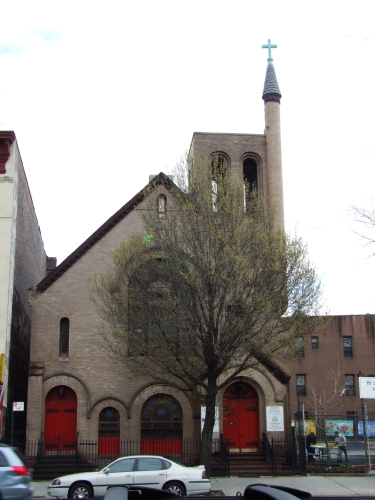Building of the Day: 4917 4th Avenue
Brooklyn, one building at a time. Name: St. Andrew’s Episcopal Church Address: 4917 4th Avenue Cross Streets: 49th and 50th Streets Neighborhood: Sunset Park Year Built: 1893 Architectural Style: Romanesque Revival Architect: L.B. Valk & Son Other Work by Architect: Several churches in Brooklyn, plus the Lillian Ward house and adjoining row in Park Slope…

Brooklyn, one building at a time.
Name: St. Andrew’s Episcopal Church
Address: 4917 4th Avenue
Cross Streets: 49th and 50th Streets
Neighborhood: Sunset Park
Year Built: 1893
Architectural Style: Romanesque Revival
Architect: L.B. Valk & Son
Other Work by Architect: Several churches in Brooklyn, plus the Lillian Ward house and adjoining row in Park Slope
Landmarked: No. Listed with Sunset Park neighborhood on the National Register of Historic Places (1988)
The story: This is the oldest church in Sunset Park, built when the neighborhood was just beginning to undergo a transformation from randomly scattered wood framed houses to masonry rows of brownstones and limestones. It’s an interesting church building, designed by one of the most prolific and important church architects in the country at the time, Lawrence B. Valk.
Lawrence B. Valk, who designed under the firm name of L.B. Valk and Son, knew his way around churches. His designs for ecclesiastical buildings can be found from the New York/Long Island area through Michigan, New Orleans, and on to California, where he and his son eventually located. He specialized in Protestant Churches, and literally wrote the book on them, in 1873, titled “Church Architecture,” in which he stated, ““Churches are for the salvation of souls, not the architectural display at the sacrifice of comfort.”
All of his churches are modest, yet quite good, mostly in the Richardsonian Romanesque Revival style. This church is no different. It’s quite laid back, not even on the corner, and its façade is a series of beautifully proportioned arches, from the large upper arched stained glass window, to the doors on either side of the 4th Avenue side, joined by an irregular group of windows. Another tall, narrow arched window breaks up the façade above the left side door, and at the very top by the pitched roof, and the theme is carried up into the bell tower, broken by even more arches. The whole building is really a fine example of how a simple design element can be used to great advantage.
Valk was a master at churches, but he was no slouch in homes, either. His most famous houses in Brooklyn are the group at 7th Avenue and Sterling; the Lillian Ward house, and its neighbors. They, too show great skill in putting together disparate pieces for a united, and in the case of the Ward house, interesting façade. After years in New York City, Lawrence Valk and his son Arthur left in the late 1890s, and set up their practice in Los Angeles. Son Arthur soon became a noted designer of movie theaters.
When one looks at this church, as well as all of the other older buildings on 4th Avenue, you have to realize that they were once on one of the most beautiful streets in Brooklyn, a boulevard with trees and plants running down the center. As the Avenue changed, so did everything on it, and today, the church, still as beautiful a design as before, becomes lost in the streetscape. It’s too bad, it’s a great building, and is now serving the spiritual needs of a Spanish-speaking congregation. GMAP












What's Your Take? Leave a Comment